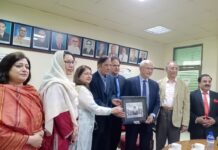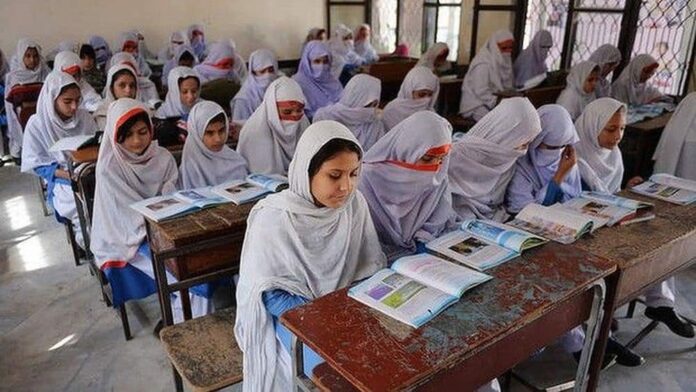Ansha, a precocious 12-year-old from a rural village in Punjab, harboured aspirations of becoming a doctor. Despite excelling academically in her local school amidst deteriorating infrastructure and outdated textbooks, her educational journey faced a significant setback in Class 7. Her parents were compelled to withdraw her from school due to the absence of secondary educational institutions in their vicinity. Ansha’s academic aspirations were thus suspended, mirroring the plight of millions of Pakistani children who are deprived of quality education due to systemic deficiencies. This situation starkly illustrates the state’s inadequate prioritization of its educational system.
The nation’s education system can be likened to a dilapidated roadway riddled with potholes. Despite the implementation of numerous policies and reforms, the system continues to grapple with its inability to adequately address the needs of its students. The severity of this issue is underscored by the alarming statistic reported by UNICEF, which indicates that approximately 22.8 million children between the ages of 5 and 16 have dropped out of primary education. This figure poignantly highlights the extent of the systemic failures within the educational framework. The critical question that arises is: where are the promising young minds who possess the potential to drive the country towards a more prosperous future?
The inadequate state of the education system can be attributed to various factors, with a significant contributor being the insufficient allocation of funding. According to the Institute of Strategic Studies Islamabad (ISSI), Pakistan allocates approximately 1.17 percent of its GDP to education, which is markedly below the recommended range of four to six percent. This underinvestment results in overcrowded classrooms, obsolete textbooks, and inadequately trained educators. In such a deficient environment, it is challenging for students to achieve their full potential and thrive academically.
When students lack access to a clean and secure learning environment, the process of education becomes significantly impeded. Many schools, particularly in rural areas, are devoid of essential facilities such as potable water and functional sanitation. Envision attempting to focus on a mathematics lesson amidst a deteriorating school infrastructure. Such conditions, as reported by numerous education experts, underscore the current state of the educational system. This scenario vividly illustrates the prevailing deficiencies within the educational infrastructure of the region.
The curriculum represents a core factor contributing to the deficiencies within the education system, as it frequently appears outdated and disconnected from contemporary relevance. Students are required to spend extensive periods memorizing facts solely for examination purposes, rather than developing critical thinking skills or acquiring practical knowledge. This approach raises questions about the rationale behind inundating students with information that is unlikely to be applicable in real-world contexts. The emphasis on rote memorization over the cultivation of analytical and practical abilities further exacerbates the educational shortcomings, highlighting a fundamental misalignment between educational content and the skills necessary for success beyond the classroom.
Moreover, teachers are widely regarded as the cornerstone of any education system; however, they frequently lack sufficient professional training. Evidence indicates that over 50 percent of teachers in Pakistan do not possess formal pedagogical training. This deficit in professional development undermines their ability to inspire and educate students effectively. The absence of adequate skills and support mechanisms severely impedes teachers’ capacity to deliver quality instruction and foster an engaging learning environment. Consequently, the efficacy of the educational system is compromised, as teachers struggle to meet the educational needs and aspirations of their students. This situation highlights a critical area of concern within the broader framework of educational reform and underscores the need for enhanced investment in teacher training and professional development.
The education system in Pakistan requires substantial reform to address its critical deficiencies. By tackling fundamental issues such as inadequate funding, substandard infrastructure, outdated curricula, and entrenched societal barriers, the nation can create a more promising future for its youth. Investing in education is not merely an obligation but represents a strategic opportunity for national advancement. Successfully navigating these challenges holds the potential to produce a robust and capable generation, prepared to confront global challenges and contribute meaningfully to societal progress.
When teachers experience a lack of motivation, their engagement with students may become minimal, despite their physical presence in the classroom. A teacher’s enthusiasm has the potential to inspire a passion for learning, yet, in numerous instances, this enthusiasm is conspicuously absent. Improving compensation and working conditions could significantly enhance teacher morale; however, many educational institutions fail to address these critical issues. The failure to adequately address these factors undermines the potential for teachers to foster a stimulating and effective learning environment. Consequently, addressing the motivational challenges faced by educators is essential for enhancing overall educational quality and student outcomes.
Poverty significantly impacts access to education, serving as a major barrier for many families, particularly those in rural areas. The financial constraints faced by these families often preclude them from affording educational expenses, leading to the necessity of pulling children out of school to contribute to the household income. This economic pressure forces children into labour, thus hindering their educational opportunities.
Consequently, this perpetuates a cycle of poverty, where the lack of education contributes to continued financial instability. This cyclical pattern not only restricts educational access but also entrenches socioeconomic disparities, reinforcing a self-sustaining loop of poverty and limited educational attainment. Addressing this issue requires targeted interventions to break this cycle and improve access to education for underprivileged communities.
Furthermore, girls encounter substantial barriers in accessing education, largely due to prevailing cultural norms that frequently prioritize the education of boys over that of girls. These societal constraints not only restrict the individual educational opportunities for girls but also impede broader national development. The systemic undervaluing of girls’ education undermines their potential contributions to society and hampers overall progress. Addressing these gender-based educational disparities is crucial for advancing equitable educational outcomes and fostering inclusive growth.
To effect a transformative improvement in the education system in Pakistan, it is imperative for the government to significantly increase its investment in this sector. Allocating at least 6 percent of the GDP to education would provide the necessary financial resources to develop and enhance educational infrastructure, offer comprehensive training programs for teachers, and produce high-quality educational materials. Such an investment would not only address the immediate deficiencies within the educational system but also lay a solid foundation for long-term educational reform. By prioritizing substantial funding, the government can catalyze meaningful advancements in educational quality and accessibility, ultimately fostering a more effective and equitable learning environment for all students.
Revising the curriculum to align with contemporary needs is essential. This entails emphasizing the development of critical thinking, problem-solving abilities, and vocational skills. Instead of prioritizing rote memorization, the focus should shift towards fostering innovative thinking among students, equipping them with the capacity to adapt to real-world challenges. Such an updated curriculum would better prepare students for the complexities of the modern world by promoting practical and analytical skills that are crucial for their future success.
Advancing gender equality in education must be considered a paramount objective. Implementing targeted scholarships and resources for girls could contribute significantly to creating a more equitable educational environment. Envision a future in which every child, irrespective of gender, is afforded equal opportunities to achieve success. This approach would help to address existing disparities and promote a more inclusive and just educational system.
Fostering community engagement can facilitate feasible improvements within the education system. By enlisting the support of local leaders and organizations, schools can obtain the necessary resources and backing for their advancement. Initiatives driven by community involvement can result in customized educational solutions that address specific local needs and contexts, thereby enhancing the relevance and effectiveness of educational interventions.
The education system in Pakistan requires substantial reform to address its critical deficiencies. By tackling fundamental issues such as inadequate funding, substandard infrastructure, outdated curricula, and entrenched societal barriers, the nation can create a more promising future for its youth. Investing in education is not merely an obligation but represents a strategic opportunity for national advancement. Successfully navigating these challenges holds the potential to produce a robust and capable generation, prepared to confront global challenges and contribute meaningfully to societal progress.






















